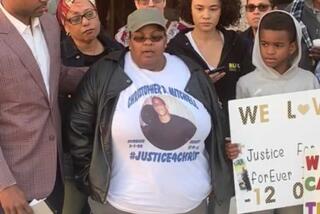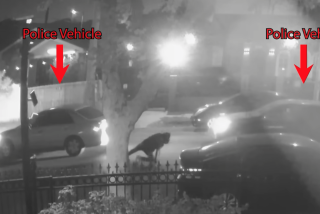Grief-stricken family demands answers after Torrance police fatally shoot woman
Ronnie Shirley can’t wrap his head around the many questions he has about the death of his 39-year-old daughter, who was shot and killed by Torrance police last month.
He struggles to understand why three Torrance police officers shot at his daughter, Michelle Lee Shirley, as she was driving in the city on the afternoon of Oct. 31. It was clear, he said, she had been in some type of accident before the shooting because her car was damaged and she was probably in distress.
Torrance police said they did what they had to do to prevent a larger tragedy.
“It was a losing situation by all involved, but we tried to stop that car,” said Sgt. Paul Kranke. “We didn’t want to do this.”
It was a losing situation by all involved, but we tried to stop that car. We didn’t want to do this.
— Sgt. Paul Kranke
On Thursday, Ronnie Shirley and his wife filed a claim for civil rights violations, demanding more information about what led up to their daughter’s fateful encounter with police.
Boris Treyzon, an attorney representing the Shirley family, said the parents haven’t decided whether to file a lawsuit, but he has filed notices, asking local agencies to preserve evidence. The attorney and his firm are scouring social media, looking for more videos of the shooting. So far, Treyzon has obtained two videos.
From the videos, he said, Shirley appeared to be “acting irrationally” and that her car had signs of a “very serious accident.” In the moments leading up to the shooting, Treyzon said it appeared police had her car “confined” near a gas station and that officers appeared to “wave her through.”
“She starts driving, she appears to be making a turn, then all of a sudden 20 shots ring out,” Treyzon said. “We don’t understand why 20 shots are fired.”
Kranke said he understands the parents’ grief, but that police had no way of knowing that Shirley was experiencing a mental episode when they encountered her.
“There is nothing to alert us that someone is going through a mental episode,” he said. “She didn’t want to be stopped.”
According to police, multiple callers had reported an erratic driver in the area of Arlington and Post avenues about 2:28 p.m. The vehicle had extensive collision damage and the side airbags had been deployed.
Police spotted the vehicle, which they said had been driving dangerously, and began pursuing it through residential streets for several minutes. After driving for more than a mile, police used a precision immobilization technique to disable her vehicle at Sepulveda Boulevard and Cabrillo Avenue.
While in reverse, the vehicle accelerated and struck a police cruiser, Kranke said. Then, Michelle Shirley drove forward and rammed into a second cruiser, according to Kranke.
That’s when three officers opened fire on the vehicle. Kranke said he doesn’t know how many shots were fired.
Michelle was wounded and taken to an area hospital, where she died about 30 minutes later.
Kranke said officers were faced with limited options at the time. It was a busy Halloween afternoon and children had just been released from nearby elementary and high schools, he said.
“We would have had a major tragedy,” Kranke said.
Michelle’s vehicle, he said, was essentially a weapon and posed a significant threat because she tried to run over the officers.
Geoff Alpert, a criminology professor at the University of South Carolina who has researched police policies and training in pursuits, said the only other tactic officers could have used to stop Michelle’s vehicle would have been to block her in.
Still, he said, the situation was likely unfolding quickly and they couldn’t allow her to keep going.
“She was just like a guided missile,” Alpert said.
To her father, Michelle was a bright woman who was a loving mother to her 14-year-old son. She studied law and had an ambition of becoming an attorney, but never passed the state exam, her father said.
Michelle’s struggles with bipolar disorder were not a secret to those who knew her.
She talked about her battle in an video, wanting to raise awareness about mental illness.
“If I could rewind time and go back 10 years I would have taken my first diagnosis more seriously,” she said.
Her symptoms began when she was an undergraduate in college.
Sleepless nights led to an “overload of creative ideas” that went unfinished, she said. Her thoughts became unmanageable, and she set a fire inside her condominium.
“That woke me to the reality I had bipolar disorder,” she said. “I could not just blame stress or the devil. This time I took the diagnosis seriously. I learned that for some unexplained reason, all of a sudden, my brain will just kick into high gear and start processing information too quickly.”
Times staff writer Matt Hamilton contributed to this report.
For breaking news in California, follow @VeronicaRochaLA on Twitter.
ALSO
Nearly 200 arrested in third night of anti-Trump protests in downtown L.A.
Two Newport Beach fires that burn industrial lot, middle school building deemed ‘suspicious’
Flights for 1,500 passengers canceled at LAX after a fender-bender between truck and plane
More to Read
Sign up for Essential California
The most important California stories and recommendations in your inbox every morning.
You may occasionally receive promotional content from the Los Angeles Times.










